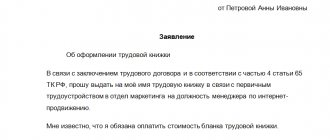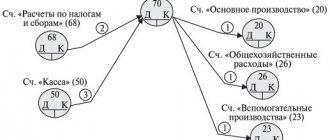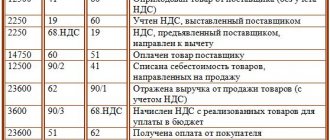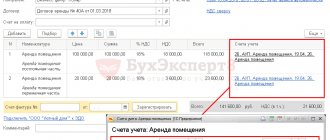The role of the primary document in accounting
Primary documents are documents with the help of which the company formalizes the economic events that occurred at the enterprise (Clause 1, Article 9 of the Law “On Accounting” dated December 6, 2011 No. 402-FZ).
The first thing that accountants of any organization should clearly understand is that today there is no specific mandatory list of forms for primary accounting documents. Any company determines for itself the forms of primary documents depending on the purpose of their use.
However, for such documents a list of mandatory details is legally established (Clause 2, Article 9 of Law No. 402-FZ).
IMPORTANT! The forms used in accounting must be fixed in the accounting policy of the organization (clause 4 of PBU 21/2008, approved by order of the Ministry of Finance of the Russian Federation dated October 6, 2008 No. 106n).
For information about how long primary documents need to be stored, read the material “What is the period of storage of documents in an organization’s archive?”
Please note that as of October 26, 2020, new sanctions for improper storage of documents apply. Read more about this in ConsultantPlus. Trial access to the system is provided free of charge.
What applies to accounting documents
Documents regulating accounting are formed according to the order in which they were compiled, that is, they are divided into primary and consolidated. The basis for making accounting entries are primary accounting documents. They can be generated directly at the enterprise, or they can be received from the outside - from suppliers, buyers, and other counterparties. The main accounting documents related to the primary ones are invoices, payment, cash, bank and other documents. Summary reports are compiled on the basis of primary data and contain generalized information.
According to their content, they can take on material and monetary values. The material part reflects the presence and movement of commodity and other valuables. For example, acts of acceptance and transfer, invoices for the release of goods give an accurate idea of the types and quantities of property being moved. A cost estimate of the operation performed is also given.
Some papers relate exclusively to settlement ones. We are talking about pay slips, cash orders, bank statements. The information they carry is exclusively financial in nature - the status of settlements with contractors, wages to employees.
Until recently, the requirement for the mandatory use of unified forms in accounting remained. The entry into force of Law No. 402-FZ on accounting makes it possible for the management of organizations to independently develop forms of primary documents. But at the same time, some requirements for the presence of mandatory details remain. That is, in primary accounting, the only valid accounting document is a form reflecting the following information:
- name and date of preparation of the form;
- details of the business entity;
- the content of the operation and its characteristics in monetary and quantitative terms;
- signatures of responsible persons.
List of possible primary accounting documents
The list of primary accounting documents in 2020-2021 may be as follows:
- Packing list. This is a document that reflects the list of transferred inventory items. The invoice is issued in 2 copies and contains information that is subsequently reflected in the invoice. The invoice is signed by representatives of both parties involved in the transaction and certified by a seal (if the company uses it in its practice).
Read about its most commonly used form in the article “Unified form TORG-12 - form and sample.”
- Record of acceptance. It is drawn up upon completion of certain works (services) to confirm that the result of the work meets the original requirements of the contract.
See a sample of such an act here.
- Primary documents for payment of wages to personnel (for example, pay slips).
For more information about these statements, see the article “Sample of filling out the payroll statement T 49” .
- Documents related to the presence of fixed assets - here the company can draw up such documentation from the list of primary accounting documents:
- Certificate of acceptance and transfer of fixed assets in the OS-1 form - upon receipt or disposal of an object not related to buildings or structures.
For more information about this act, see the material “Unified Form No. OS-1 - Certificate of Acceptance and Transfer of OS” .
- If the fixed asset is a building or structure, then its receipt or disposal is formalized by an act in the OS-1a form.
For more information, see the article “Unified form No. OS-1a - form and sample” .
- The write-off of an asset is formalized by an act in the OS-4 form.
For more details, see the material “Unified Form No. OS-4 - Act on the write-off of an asset” .
- If it is necessary to document the fact of the inventory carried out, an inventory list of the fixed assets is drawn up in the INV-1 form.
For more information about such a primary document, see the article “Unified form No. INV-1 - form and sample” .
- If the inventory was carried out in relation to intangible assets, then the inventory will be compiled according to the INV-1a form.
For more information, see the material “Unified form No. INV-1a - form and sample” .
- A separate group of primary documents are cash documents. These include, in particular, the following list of primary accounting documents for 2020-2021:
- Receipt cash order.
For more information about its preparation, see the article “How is a cash receipt order (PKO) filled out?” .
- Account cash warrant.
For details about it, see the material “Cash expenditure order - form and sample.”
- Payment order.
Read about the rules for preparing this document here.
- Advance report.
Read about what to follow when drawing up such a document in this article.
- The act of offsetting mutual claims.
Read about the specifics of using this document here.
- Accounting information.
For information on the principles of its execution, see the material “Accounting certificate of error correction - sample”.
The above list does not exhaust the entire scope of primary documents used in accounting, and can be expanded depending on the characteristics of the accounting carried out in each specific organization.
You will find a complete list of primary documents in the Directory from ConsultantPlus. Get trial access to the system and proceed to the list.
IMPORTANT! They are not primary accounting documents from the list 2020-2021 - the list was proposed above:
- Agreement . This is a document that stipulates the rights, obligations and responsibilities of the parties involved in the transaction, the terms and procedure for settlement, special conditions, etc. Its data is used when organizing accounting for the analytics of settlements with counterparties, but it itself does not generate accounting transactions.
- Check. This document reflects the amount that the buyer agrees to pay by accepting the supplier's terms. The invoice may contain additional information about the terms of the transaction (terms, payment and delivery procedures, etc.), i.e. it supplements the contract.
- Invoice. This document is drawn up for tax purposes, since on its basis buyers accept for deduction the amounts of VAT presented by suppliers (clause 1 of Article 169 of the Tax Code of the Russian Federation). Thus, in the absence of other documents characterizing a particular transaction, it will be impossible to confirm expenses for this transaction with an invoice (letter of the Ministry of Finance of the Russian Federation dated June 25, 2007 No. 03-03-06/1/392, Federal Tax Service dated March 31, 2006 No. 02-3 -08/31, resolution of the Federal Antimonopoly Service of the East Siberian District dated April 19, 2006 No. A78-4606/05-S2-20/317-F02-1135/06-S1).
It should be borne in mind that the unified forms of primary accounting documents given in the list are not mandatory for use, since since 2013 (after the adoption of Law No. 402-FZ), forms of such forms can be developed independently. But in most cases they continue to be used. Therefore, in 2020–2021, the list of unified forms of primary accounting documents contained in the resolutions of the State Statistics Committee continues to remain relevant.
What are accounting documents used for?
For organizations and even entrepreneurs, the importance of accounting documents is great. They not only serve as confirmation of accomplished facts of economic activity, but also help determine the current financial condition of the company. On their basis, subjects carry out tax calculations, while reducing the tax base is possible only if they have documents correctly drawn up from the point of view of legislation.
The absence of the necessary primary documents, certificates, and statements can subsequently create many problems for the organization, raising additional questions from regulatory authorities. Often this fact serves as the basis for recalculating the tax base.
What accounting documents should an LLC have to ensure the ongoing operation of the enterprise? Depending on the specifics of the work, these are documents regulating the activities of the enterprise - orders, instructions, accounting policies. Confirmation of the facts of income received and expenses made are invoices, invoices, payslips with personnel, and other cash and bank documents. To simplify the accounting procedure, turnover and accumulative statements containing general information about homogeneous transactions are widely used.
What information should the forms of primary documents contain?
Despite the fact that there are currently no mandatory primary documents for all forms, the legislator has established requirements for the content of such documents. The list of mandatory details that must be contained in each primary document is given in paragraph 2 of Art. 9 of Law No. 402-FZ. These are, in particular:
- document's name;
- the date on which such document was drawn up;
- information about the person who compiled the document (name of the company or individual entrepreneur);
- the essence of the fact of economic life that was formalized by this document;
- monetary, numerical characteristics, measures of the event that occurred (for example, in what volume, in what units and for what amount were the products sold to customers);
- information about the responsible specialists who documented the event, as well as the signatures of such specialists.
If the primary source does not meet the requirements, the organization may also face tax consequences.
Get free access to K+ and learn about the most common complaints tax authorities have and how to counter them.
For information on how the right to sign is delegated, read the article “Order on the right to sign primary documents - sample.”
The concept of “Accounting document”, essence and purpose.
Documentary confirmation of accounting transactions is one of the main stages of accounting work.
Information about the facts of a transaction, or about obtaining permission to carry it out, can be reflected on various media, but not a single business transaction should be recorded in accounting without formalizing it with the appropriate document. An accounting document is a written confirmation of the fact of a business transaction, or evidence of obtaining permission to carry out this operation.
Accounting documents used in accounting are different in nature, and each document includes a number of indicators. Such indicators, containing information about a business transaction, are called details . All details are classified as:
- constants and variables;
- mandatory and optional.
Permanent and variable details differ from each other in that permanent details are used in one organization for a long period of time (name of the organization, its legal address, bank details, etc.). Variable details are determined by the essence of the business transaction (the number of materials received in the invoice, the name of the product released into production, etc.).
Mandatory details must be contained in each accounting document (name of the document - PKO, RKO, invoice; contents of the transaction; signatures; date, document number; name of the enterprise, etc.). The composition of the mandatory details is approved in the Regulations on accounting and financial reporting in the Russian Federation.
The management of the organization approves by order the list of persons authorized to sign primary documents. Cash and settlement documents are subject to mandatory signing by the director and chief accountant.
Additional details depend on the content of the business transaction and the purpose of the document (telephone number, basis for the transaction, full name of the performer, receipt mark, etc.).
The systemic arrangement of details in an accounting document is the structure of the document . The structure can have the following forms: questionnaire, tabular, combined.
An accounting document with a questionnaire structure is characterized by the arrangement of details as in a standard questionnaire (question and answer). Details in documents with a tabular structure are filled in in the form of a table. The combined structure in accounting documents is determined by the arrangement of a number of details as in a questionnaire, and the row according to a tabular structure.
The State Statistics Committee of Russia, in agreement with the interested executive authorities (Ministry of Economy of the Russian Federation, Ministry of Finance of the Russian Federation, etc.), approves unified forms of accounting documents. Documents for which unified forms are approved must be drawn up in accordance with them. These forms have certain requirements for the execution of an accounting document, and each document has its own code designation (All-Union Classifier of Management Documentation (OKUD)). Documents that do not have a unified form must be approved in the accounting policies of the organization.
Primary documents and accounting registers
How can primary accounting documents be classified?
If the primary document was issued by the company itself, then it can belong either to the group of internal or to the group of external. A document that is drawn up within the company and extends its effect to the compiler company is an internal primary document. If the document was received from the outside (or compiled by the company and issued to the outside), then it will be an external primary document.
The company's internal documents are divided into the following categories:
- Primary administrative documents are those with which a company gives orders to any of its structural units or employees. This category includes company orders, instructions, etc.
- Executive primary documents. In them, the company reflects the fact that a certain economic event has occurred.
- Accounting documents. With their help, the company systematizes and summarizes information contained in other administrative and supporting documents.
After a business event has been documented as a primary document, it is then necessary to reflect the event in the accounting registers. They, in fact, are carriers of ordered information; they accumulate and distribute the characteristics and indicators of business transactions.
The following registers are distinguished by their appearance:
- books;
- cards;
- free sheets.
Based on the method of maintaining the register, the following groups are distinguished:
- Chronological registers. They record the events that happened sequentially - from the first in time to the last.
- Systematic registers. In them, the company classifies completed transactions by economic content (for example, a cash book).
- Combined registers.
According to the criterion of the content of information reflected in the registers, the following are distinguished:
- synthetic registers (for example, a journal order);
- analytical registers (payroll);
- combined registers, in the context of which the company carries out both synthetic and analytical accounting.
For more information about accounting registers, see the article “Accounting registers (forms, samples)” .
Documentation is an element of the accounting method
The financial and economic activities of an organization are accompanied by numerous operations. In accordance with the Law “On Accounting”, each fact of economic life (business transaction) is subject to registration as a primary accounting document. For this purpose, one of the elements of the accounting method is used - documentation, i.e. the main method of accounting monitoring of the economic activities of an organization, reflecting accounting objects, and primary control. Each operation, regardless of volume and content, is formalized in a document at the time of its completion and is the first stage of accounting.
A document (from the Latin documentum - instructive example, evidence, evidence) is written evidence confirming the fact of a business transaction and the right to carry it out.
The primary accounting document must be drawn up when a fact of economic life is committed, and if this is not possible, immediately after its completion. The primary accounting document is drawn up on paper and (or) in the form of an electronic document signed with an electronic signature.
Electronic document - documented information presented in electronic form, i.e. in a form suitable for human perception using electronic computers, as well as for transmission over information and telecommunication networks or processing in information systems.
Federal Law “On Electronic Signature” dated April 6, 2011 No. 63-FZ defines an electronic signature as information in electronic form that is attached to other information in electronic form (signed information) and that is used for a specific person signing the information.
If, in accordance with the legislation of the Russian Federation, primary accounting documents, including in the form of an electronic document, are seized, copies of the seized documents, made in the manner established by the legislation of the Russian Federation, are included in the accounting documents.
If the legislation of the Russian Federation or an agreement provides for the submission of a primary accounting document to another person or to a state body on paper, an economic entity (organization) is obliged, at the request of another person or government body, at its own expense, to make copies on paper of the primary accounting document drawn up in in the form of an electronic document.
The forms of primary accounting documents are approved by the head of the economic entity on the recommendation of the official responsible for maintaining accounting records. The new law “On Accounting” has abolished the concept of “unified forms”; now organizations can develop all forms of primary documents independently. In order for the forms of primary documents on the basis of which the fact of a business transaction is recorded to become legitimate, they must be approved by order of the manager (possibly as part of the accounting policy) and have mandatory details.
Documentation serves as the basis for subsequent accounting entries and ensures the accuracy, reliability and indisputability of accounting indicators, as well as the possibility of their control.
Results
At present, there are no mandatory forms and lists of primary accounting documents: any business entity has the right to independently determine for itself the forms of primary documents that it will use in its activities.
At the same time, the most common primary accounting documents are those that have analogues among the unified forms approved by the State Statistics Committee.
After the primary document is drawn up, it is necessary to transfer information from it to the accounting register.
Sources:
- Federal Law of December 6, 2011 N 402-FZ “On Accounting”
- Order of the Ministry of Finance of Russia dated October 6, 2008 N 106n
You can find more complete information on the topic in ConsultantPlus. Free trial access to the system for 2 days.
Answers based on test results for programmed control
| Chapter number and title | Question number | Correct answer number |
| Chapter 7. Organization of initial observation and documentation | 1 | 2 |
| 2 | 2, 3 | |
| 3 | 1, 2 | |
| 4 | 1 | |
| 5 | 3 | |
| 6 | 4 | |
| 7 | 1 | |
| 8 | 3 | |
| 9 | 3 | |
| 10 | 3 | |
| 11 | 1 | |
| 12 | 3 | |
| 13 | 2 | |
| 14 | 3 | |
| 15 | 2 | |
| 16 | 3 |
See the Regulations on the procedure and period for storing documents of joint-stock companies (approved by Resolution of the Federal Commission for the Securities Market of Russia dated July 16, 2003 No. 03-33/PS).
User, since you have reached this line, you have found something interesting or useful for yourself here. I hope you viewed the site in the Firefox browser, which alone correctly reflects the formulas found on the pages. If you liked the content, please support the site financially. Please disable ad blockers and click on the couple of banners at the top of the page. It won’t cost you anything, you’ll only see what you’ve already looked for or are looking for, and you’ll help the site stay afloat.
Requirements for filling out documents
Documents must be drawn up in a timely manner, as a rule, at the time of the transaction, or if for some reason this is impossible, immediately after the completion of the transaction.
When selling goods, products, works and services using cash registers, it is allowed to draw up a primary accounting document at least once a day after its completion on the basis of cash receipts.
The documents must contain all details that reflect reliable data. Documents can be filled out with ballpoint pen paste, chemical pencil, using typewriters or in a fully automated way. The document must be drawn up clearly, clearly, without erasures; it is not allowed to make entries in documents with a simple pencil. Final entries related to the transfer of valuables must be written in words. Free lines must be crossed out.
The list of persons authorized to sign primary accounting documents is approved by the head of the organization in agreement with the chief accountant. Documents used to document facts of economic life related to funds are signed by the head of the organization and the chief accountant or their authorized persons.
Document classification
A large number of different documents are used to reflect business transactions. For the correct use of documents, it is customary to group them, i.e. draw up consolidated accounting documents that are classified according to homogeneous characteristics: by purpose, order of preparation, method of recording transactions, place of preparation, order of filling.
According to their purpose, documents are divided into administrative, executive (exculpatory), accounting, and combined.
Administrative documents contain an order (instruction) to carry out a business transaction. However, they do not confirm the fact of its implementation, and therefore are not the basis for accounts. For example, orders, payment order to the bank for the transfer of taxes, etc.
Supporting documents confirm the fact of a business transaction and serve as the basis in accounting for reflecting business transactions. For example, invoices confirming expenses incurred, acts of acceptance and transfer of fixed assets, etc.
Accounting documents are drawn up by accounting employees in cases where there are no other documents to record a business transaction, or for the purpose of preparing administrative and corroborative documents for reflection in accounting. For example, accumulative statements, calculations of the actual cost of products, various types of certificates and calculations prepared by the accounting department, etc.
Combined documents simultaneously perform the functions of administrative and acquittal, acquittal and accounting formalities. For example, an invoice for the release of material assets contains an order to release materials from the warehouse to the workshop, as well as registration of the actual issue.
According to the order in which documents are drawn up, there are primary and summary documents.
Primary documents are drawn up for each individual transaction at the time of its completion. For example, an incoming cash order, an outgoing cash order, payment requests, acts for writing off fixed assets, etc.
Consolidated documents are drawn up on the basis of previously compiled primary documents. Their use facilitates control of homogeneous operations. They can be executive, accounting or combined. For example, advance and cash reports, grouping and accumulative statements. In particular, the advance report, being a combined one, performs the functions of a supporting and accounting document. It provides a complete description of settlements with accountable persons: the balance or overexpenditure of the previous advance, the size of this advance, the amount spent, the balance and the date of its entry into the cash register or the overexpenditure and the date of its reimbursement by the enterprise. In addition, the advance report provides a description of the invoiced production expenses after the report has been reviewed and approved. On the reverse side of the report there is a list of individual expenses and their supporting documents.
Based on the method of recording transactions, documents are divided into one-time and cumulative.
One-time documents are used only once to reflect a single transaction or several simultaneously performed transactions. After registration, the one-time document goes to the accounting department and serves as the basis for reflection in accounting. For example, incoming and outgoing cash orders, payroll statements, etc.
Cumulative documents are compiled over a certain period (week, decade, month) to reflect homogeneous recurring transactions that are recorded in them as they occur. At the end of the period, the totals for the indicators used for the accounts are calculated. It should be noted that cumulative documents differ from summary documents in that a summary document is drawn up on the basis of primary documents and is their summary, while a cumulative document is a primary document compiled gradually by accumulating transactions. Accumulation documents include limit cards, two-week or monthly orders, etc.
Depending on the place where they are drawn up, documents can be internal or external.
Internal documents are drawn up at the enterprise to reflect internal operations. For example, cash receipts and expenditure orders, invoices, acts, payroll statements, etc.
External documents are filled out outside the boundaries of the given enterprise and are received in formalized form. For example, invoices, bank statements, delivery notes, etc.
According to the order in which they are filled out, documents can be classified into those compiled manually and using computer technology. Some documents must be completed manually, such as cash checks
Documents compiled with the help of computer technology automatically record information about transactions performed at the time of their completion.








